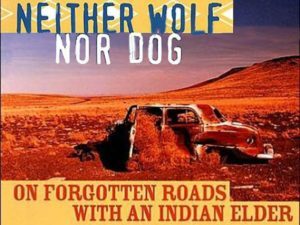“Ways”
I just finished reading, in two extended sittings (unusual for me) the new edition of Kent  Nerburn’s, Neither Wolf nor Dog. It is a semi-fictional narrative of an actual friendship between a white man and an elderly Indian that unfolds gently and gracefully, with a humor and an openness that allows the sorrow, shame, and anger felt by the older man to be expressed in ways that both instruct and inspire.
Nerburn’s, Neither Wolf nor Dog. It is a semi-fictional narrative of an actual friendship between a white man and an elderly Indian that unfolds gently and gracefully, with a humor and an openness that allows the sorrow, shame, and anger felt by the older man to be expressed in ways that both instruct and inspire.
Nerburn avoids the twin traps that ensnare most non-native writers – either an anthropological distance from or a romanticized veneration of native culture. The dialogue that emerges from the characters is honest and earthy. The relationships are real rather than idealized. The story unfolds without being weighed down by literary frills, yet the writing is often beautiful and moving.
Native American philosophy/spirituality has many similarities to the Taoism of Lao-Tzu. This seems only natural as both arise from a quiet mindful observation of the “Way Things Work.” Both “Ways” assume that human beings function best when they align themselves with the flow of nature and perceive themselves as part of a larger Whole. Both assume that silence is more helpful than words; that patiently waiting is better than precipitous action; that actions need never be hampered by a false urgency; that the best work is done without thought of gain; that an internal virtue flows through all beings; that a cooperative anarchy is the best form of government; and that leaders should be humble guides rather than rulers.
I enjoyed the descriptions of the patient and quiet silence that permeated the lives of the older Native Americans in the story. I was also aware that I rarely experience such a quality in my own life or in the culture around me. I could feel the white narrator’s discomfort as he continually fell into the trap of speaking too soon, saying too much, and being unaware of his own cultural biases. He does not idealize native culture and makes it only too clear how difficult it is for the modern Indian to “Walk the Way.” Perhaps it is as difficult as it is for me to walk my own “Tao/Way” in a world that ignores and dismisses all ancient “Ways” as uncivilized, impractical, and quixotic.
I write of my experience with this wonderful book because I believe it is an excellent expression of the Tao as it manifests itself in a culture other than my own or that of ancient China. If you have the chance to read it I would hope that you catch a glimpse of Taoist living from a different perspective. Looking at the Tao through different cultural metaphors I believe we gain a deeper understanding of how this Path might manifest itself in our own lives. We’re not alone in our longing for a more authentic life. We are not alone in our sorrow over something we’ve lost that we can’t quite articulate. Billions of people in this modern world suffer from some sense of displacement, grief, and rootlessness. Perhaps if we acknowledge this common thread, we might move closer to a common understanding of the pilgrim path that winds through all our cultural wastelands. Perhaps by walking it together we will gain enough strength to reestablish it as the Way of Life for all peoples.



